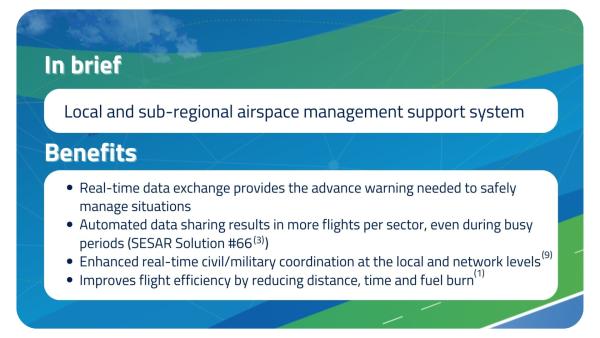Europe’s crowded skies require flexible use of airspace
SESAR provides the coordination, processes and procedures needed to make dynamic airspace management for civil and military airspace users a reality.
By adopting a flexible approach to airspace access, civil and military authorities across Europe allocate scarce capacity according to user requirements. By expanding this flexible use of airspace concept across national borders, SESAR is helping increase flight safety, capacity, and efficiency.

The flexible use of airspace (FUA) solution is a means of maximising capacity for civil use while also accommodating military training needs. As a result, airspace users can use appropriate software tools to plan efficient (and in some cases close-to-real-time) routes while taking into account variable profile areas.
However, FUA’s application remains largely confined to national airspace rather than cross-border implementation. This not only reduces potential airspace capacity, it also limits access to fuel-efficient routes.
Moving to the cross-border implementation of FUA requires enhanced civil/military coordination. It also needs new processes and procedures that can support collaborative decision making between airspace users, the EUROCONTROL Network Manager and civil and military authorities.
SESAR has helped define, develop and deploy solutions that support dynamic airspace management and provide live situational awareness to civil and military partners, allowing them to respond to both local and network needs.
The solution
Airspace management (ASM) and advanced flexible use of airspace (A-FUA) promotes cross-border operations and optimise airspace use. It relies on real-time data sharing to create common situational awareness and interoperability between all parties involved (e.g., air navigation service providers (ANSPs), military authorities, the EUROCONTROL Network Manager, airspace users).
The process starts in the pre-tactical flight phase with the continuous exchange of airspace management data among all partners. The collaborative decision-making process identifies the most suitable solutions to satisfy both civil and military requirements and updates the daily network operations plan (NOP). Enhanced notifications provide common awareness of airspace availability, including airspace activation, de-activation, modification and release of airspace structures. This information is shared by stakeholders, adding another layer of safety.
SESAR Solutions support these interactions, ensures interoperability with the EUROCONTROL Network Manager and enables stakeholders to retrieve up-to-date status information. As a result, airspace users can, for example, file optimal flight plans based on timely and accurate information. They also have the option to access further data sources, including meteorology reports, aeronautical information and short-term air traffic flow capacity management measures.
Future air-ground trajectory information sharing will enable even greater synchronisation.
The results
SESAR Solutions supports the advanced flexible use of airspace and helps reduce average flight delays year-on-year. It also increases flight efficiency by reducing distance, time and fuel burn. As a result, the technology expands airspace capacity for both civil and military users(1).
The details
To start, SESAR developed support tools, operational procedures and processes for real-time airspace status data exchange in research programmes, including advanced flexible use of airspace (SESAR Solution #31(2)), dynamic sectorisation (SESAR Solution #66(3)) and tools for complexity detection and resolution (SESAR Solution #19(4)). It then conducted live trials in partnership with the EUROCONTROL Network Manager. These activities helped refine the interoperability requirements to automatically update information supporting dynamic airspace management.
SESAR deployment covered EUROCONTROL Network Manager system upgrades, enabling real-time data exchange (SESAR AF3 2016-133 (5)) and airspace configuration changes (SESAR AF3 2016-135(6)), as well as implementation in dozens of area control centres. These ranged from regional locations like Stavanger and Nicosia to such complex environments as Bordeaux and Brussels.
In all cases, en-route flight delays decreased and continue to diminish.
In action
An application of FUA can be found in the local and sub-regional airspace management (LARA) software tool, which is now freely available from EUROCONTROL and is being deployed by ANSPs across Europe – and beyond.
ENAIRE and the Spanish Air Force are using the tool to coordinate flights with the EUROCONTROL Network Manager (SESAR AF3 2016_037_AF3(7)), while Switzerland and France are using it to operate a cluster connection. In 2023, Finland successfully integrated LARA into tactical controller working positions.
In response to user requirements at the Lisbon area control centre, Nav Portugal implemented LARA as a means of bringing more flexibility to its airspace reservation management process (SESAR AF3 #122(8)). The entry into operations of this system was a major driver for the average en-route delay reduction from 0.23 minutes per flight in the summer of 2016 to 0.07 minutes in 2017.
LARA won the civil-military cooperation award for best practices at ATCA Airspace Integration Week 2023.

References
- EUROCONTROL Advanced flexible use of airspace (AFUA)
- SESAR Solution #31: Variable profile military reserved areas and enhanced civil-military collaboration
- SESAR Solution #66: Automated support for dynamic sectorisation
- SESAR Solution #19: Automated support for traffic complexity detection and resolution
- SESAR AF3: NM system management of real time airspace data
- SESAR AF3: Implementation of pre-defined airspace configuration
- SESAR AF3: Deployment of LARA system in Spain
- SESAR #122 AF3: Nav Portugal deploys Initial ASM tool to support AFUA

